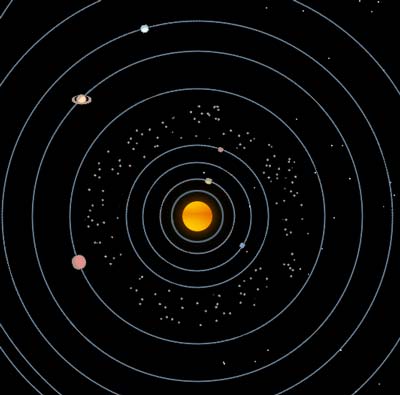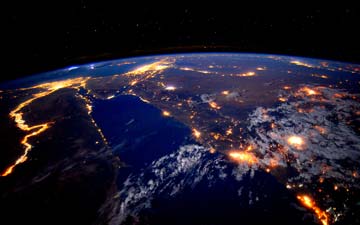Ask the Astronomer
Yeshe Fenner, a science student at Monash University in Melbourne Australia, submitted these 2 excellent questions:
The popular big bang theory states that the universe does not expand into space; rather space itself expands, 'dragging' stars etc. with it. For the recessional velocities of other stellar bodies to be observable, requires that space be expanding only between the stellar bodies.
If space were truly expanding evenly at all points (including within atomic structures) we would not detect any relative expansion (like enlarging a photo). I have heard it said that whilst space expands, the gravitational and nuclear binding forces have remained constant, thus allowing the observation of expansion. But this is most unsatisfactory because those constants are actually defined by spatial dimensions. For the gravitational constant to have remained unchanged would mean spatial dimensions have remained constant also. This is in conflict with a theory of expanding space and would render the concept of space an undefinable, unscientific abstraction.
Astronomer William Georgevich replies:
The best way to treat your question is to see it as a matter of scale. Redshifted galaxies are obviously moving away from us. At the edge of the observable universe is the "realm of darkness" and beyond that the original light of "Let There Be Light" or the Big Bang. The notion that everything is expanding from everything else (the dots on the expanding balloon model) comes from the overwhelming empirical observation of these recessional velocities.The solution for your seemingly contradictory premises is to admit that if you take the strict view that space is expanding (dragging energy/matter along with it) then you cannot employ that model to describe nuclear events and other phenomena on a smaller scale. If you take the strict view that matter/energy is expanding and creating space then you have even more problems. Our solution is to look at space, energy, and matter as interchangeable. That is, each can arise out of the other. Cosmologists keep searching for that Unified Field Theory that will elegantly and simply relate these 3 in some predictable fashion. Particle physicists are doing the same thing at the other end of scale, and they just keep coming up with new particles as they increase collision velocities in their accelerators.
Looking at the problem from the point-of-view of matter, energy, or space will always create restrictions and contradictions in the model. The solution will come from a change in point-of-view that is able to embrace these relationships seamlessly.
Here is Ms. Fenner's 2nd question:
Suppose we can detect light from the most distant objects 14 billion light years away. The radius of the observable universe is then 14 billion years and the age of the furthermost objects is 14 billion years. But 14 billion years ago, the universe was much smaller and probably closer to a singularity. So how is it that the closer an object's distance from us approaches 14-15 billion light years, the closer it is to being a singularity. Surely that entails a violation of the limit of the speed of light for the recessional velocities.
William Georgevich:
The Big Bang concept comes from simple formulae that take data from the observable Universe and run it backwards to a singularity. Timothy Ferris produced an excellent video that I have shown in my classes about what that reversal looks like. What I think you are alluding to is problems determining the Hubble Constant. I find it amusing that physicists who accept the Heisenberg Uncertainty Principle as one of the bedrocks of quantum physics are struggling to set a cosmological limit or constant. We simply are not there yet. Furthermore, as a scientist I am not ready to accept the speed of light as an absolute limiting velocity in the space-time/matter-energy continuum. (Light may be able to transpose into another form that allows trans light-speed velocities.) After all Einstein's theories came from "Gedanken Experimenten" which is German for "thought experiments". It was his expansive point-of-view or his state-of-mind, if you will, that allowed the insights that were proven years later in laboratories. I think quantum physics has arguably demonstrated that we must pay more and more attention to the "observer" since it is the observer who sets the scientific criteria.
 See an animation of the movement of planets in our solar system.
See an animation of the movement of planets in our solar system. See amazing views from space
See amazing views from space